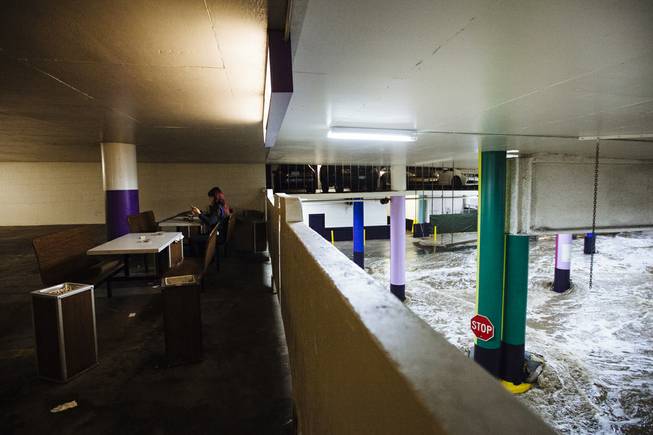
A flash flood flows through the LINQ parking garage and surrounding areas in Las Vegas, Nev. on July 6, 2015.
Thursday, July 9, 2015 | 3:49 p.m.
Now that it's monsoon season in Las Vegas, get ready for a steady string of flash-flood warnings.
Floods are one of the top three weather-related hazards Nevada residents will face. The National Weather Service already issued several flash-flood warnings this week when rain water swept through the northwest valley and flooded roads near the Linq.
If you're unsure whether to buy flood insurance or how it works, the Nevada Division of Insurance has done your homework for you. The Division released the following tips today:
Understand what flood insurance does and does not cover.
Flood insurance policies cover "water damage," which is defined as:
• Flood, surface water, waves, tidal water, tsunami, seiche, overflow of a body of water or spray from any of these, whether driven by wind or not.
• Water or sewage from outside the residence's plumbing system that enters through sewers or drains or water that enters into and overflows from within a sump pump.
• Vehicle flooding is only covered by your automobile insurance policy if you purchased comprehensive coverage.
Recent flash floods have caused property damage from mudslides or rockslides, but such damage is not covered by your home or flood insurance policy. Damage from mudslides, rockslides and other earth movements only are covered by an earthquake insurance policy or endorsement. An earth movement includes but is not limited to an earthquake, landslide, mudflow, mudslide, sinkhole, subsidence, erosion or movement resulting from improper compaction, site selection or other external forces.
Visit the Division of Insurance website for more information about flood, home and earthquake insurance.
Learn how to buy flood insurance.
A flood insurance policy is issued by the National Flood Insurance Program (NFIP), which is administered by FEMA. Visit www.Floodsmart.gov or call 1-888-379-9531.
Your existing insurance agent also can facilitate the process for applying for and obtaining a NFIP flood insurance policy.
There's a 30-day waiting period before a flood insurance policy goes into effect, though. Add an earthquake endorsement to your home insurance policy to get coverage for damage caused by an earth movement, such as a mudslide.
Here's what to do if you have flood damage to your property:
Even if you don't have flood or earthquake insurance, you still can file a claim with your home or property insurer if affected by flood or mud-related damage. This is important because if an area is declared a major federal disaster area, a proof of claim denial may be required to determine a consumer's eligibility for federal aid.

Join the Discussion:
Check this out for a full explanation of our conversion to the LiveFyre commenting system and instructions on how to sign up for an account.
Full comments policy